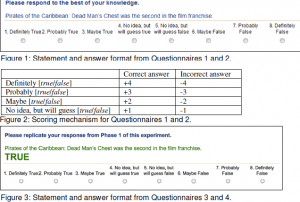Jacqueline Andros and Dr. Joseph Price, Department of Economics
Hindsight bias, or the psychological tendency to think that we “knew it all along,” has been studied for over fifty years but no study has yet thoroughly documented the specific role that gender plays in an individual’s susceptibility to this effect. This is somewhat surprising, since the existing literature on gender differences in other potentially related respects, such as competitiveness and overconfidence, is extensive. I conducted a questionnaire-based behavioral experiment to test two hypotheses: first, that male subjects are more prone to hindsight bias than female subjects; and second, that male subjects are better at correcting for their personal level of bias once they are aware of it. My findings support both these hypotheses.
I based my experimental design on previous hindsight bias studies. My experiment took place in five controlled laboratory experimental sessions, each lasting approximately 45 minutes and consisting of four questionnaires with 30 true/false statements each. I recruited 59 student subjects through e-mails to BYU Honors Program participants and students in the Economics department. I adapted the statements for my questionnaires from The Ultimate Trivial Pursuit Question & Answer Book; I selected ten questions from each of six categories: geography, entertainment, history, arts and literature, science and nature, and sports and leisure.
The first questionnaire required subjects to simply respond to a set of 30 questions (Question Set A) along an 8-point Likert scale (Figure 1). Subjects received a score for each question set based both on whether they were correct (true or false) and on how certain they were (Figure 2). Subjects received monetary compensation (a maximum of $4 for each section) based on how well they did; they were thus incentivized to answer to the best of their knowledge at all times. The second questionnaire was identical to the first questionnaire, except that subjects responded to a new set of 30 questions (Question Set B). These first two questionnaires were the standard of comparison by which I measured the effect of introducing the potential for hindsight bias in the second two questionnaires.
The second two questionnaires showed subjects the same two question sets (Questionnaire 3 re- presented Question Set A, while Questionnaire 3 re-presented Question Set B), but in these rounds subjects were also shown the correct answer and asked to replicate their original answers (Figure 3). Scores (used to calculate bias) for the third questionnaire were calculated the same way as in the first two questionnaires, but subjects’ monetary reward was based on how closely their new responses mirror their original responses. This provided incentive for subjects to match their original answers as closely as possible. At the conclusion of this third questionnaire, I calculated hindsight bias by comparing subjects’ scores in the third questionnaire to their scores on the first questionnaire. I then informed each subject of the severity of his or her personal hindsight bias in categories of extreme, moderate, or mild bias (score cutoffs for each category determined based on preliminary trials of the experiment). After receiving this information, participants proceeded to the fourth questionnaire, which tested whether individuals could correct for their own hindsight bias when they are aware of it. Subjects received Question Set B for the second time, this time with the corresponding answers. In all ways except the revelation of individual bias, the fourth questionnaire was identical to the third questionnaire.
Once my data collection was complete, I estimated the effect of gender on level of bias using the following regression equation:
biasi = β1 + β2malei + β3agei + β4marriedi + β5confidencei
I found that men have a level of bias that is 4.6 points lower than women, a difference that is 70% of a standard deviation. This difference is about twice as large as the difference based on marital status and equivalent to the effect of an age difference of 75 years. I also estimated the effect of gender on bias correction using the following regression equation:
correcti = β1 + β2malei + β3agei + β4marriedi + β5confidencei
I found that men have correction levels that are 3.96 points higher than women, amounting to a difference of 56% of a standard deviation. This difference is about 2.5 times larger than the effect of marital status and approximately equal to the effect of a six year age difference.
These results support both my original hypotheses; however, I also recognize weaknesses in my data and experimental design that provide opportunities for future improvements on my study. First of all, my sample consisted of only 59 undergraduate students, a large proportion of them economics majors; a larger and more balanced sample would allow for more conclusive results. Furthermore, it is important to consider additional factors that might distort the difference between male and female biases, especially in areas of known or plausible gender differences such as short-term memory ability. I did not control for possible memory effects; thus, these results do not distinguish between subjects’ actual hindsight bias and their mere inability to remember their previous answers accurately and gender difference in this area could be distorting my results. In future experimentation, I would introduce another trial where subjects simply attempt to replicate their original answers without receiving prompts as to the correct answer. This trial would provide me with a measure of each subject’s ability to remember original answers correctly and I would be able to appropriately control for this factor. I reported these findings in my Honors Thesis, which I successfully defended on July 13, 2012.
I gratefully acknowledge the funding of both the ORCA program and the Honors Department, as well as the guidance of my mentor Dr. Price and the assistance of fellow Economics students Lauren Noorda and Sean Lindsay in running the experiment and conducting the data analysis. I am also appreciative of my thesis committee and the entire Honors staff for their considerable and consistent help and support.

